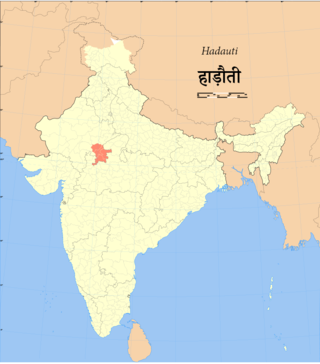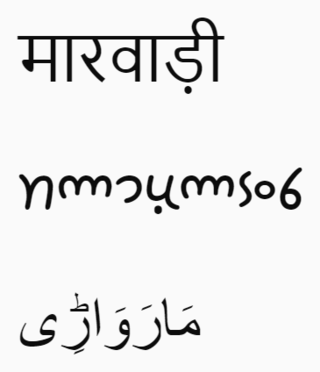
Marwari is a language within the Rajasthani language family of the Indo-Aryan languages. Marwari and its closely related varieties like Dhundhari, Shekhawati and Mewari form a part of the broader Marwari language family. It is spoken in the Indian state of Rajasthan, as well as the neighbouring states of Gujarat and Haryana, some adjacent areas in eastern parts of Pakistan, and some migrant communities in Nepal. There are two dozen varieties of Marwari.

Bagheli or Baghelkhandi is a Central Indo-Aryan language spoken in the Baghelkhand region of central India.

The Northern Indo-Aryan languages, also known as Pahāḍi languages, are a proposed group of Indo-Aryan languages spoken in the lower ranges of the Himalayas, from Nepal in the east, through the Indian states of Jammu and Kashmir, Uttarakhand, Himachal Pradesh and Punjab was coined by G. A. Grierson.
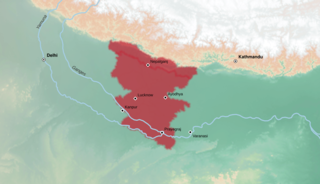
Awadhi, also known as Audhi, is an Indo-Aryan language spoken in the Awadh region of Uttar Pradesh in northern India and in Terai region of western Nepal. The name Awadh is connected to Ayodhya, the ancient city, which is regarded as the homeland of the Hindu deity Rama, the earthly avatar of Vishnu. Awadhi is also widely spoken by the diaspora of Indians descended from those who left as indentured laborers during the colonial era. Along with Braj, it was used widely as a literary vehicle before gradually merging and contributing to the development of standardized Hindi in the 19th century. Though distinct from standard Hindi, it continues to be spoken today in its unique form in many districts of central Uttar Pradesh.

Bhili, IPA:[bʱiːliː], is a Western Indo-Aryan language spoken in west-central India, in the states of Rajasthan, Gujarat, Maharashtra, and Madhya Pradesh. Other name for the language include Bhilboli; several varieties are called Garasia. Bhili is a member of the Bhil languages, which are related to Gujarati and Rajasthani. The language is written using the Devanagari script.

The Bhil languages are a group of lects spoken by the Bhil that are classified as dialects of Indo-Aryan languages such as Gujarati and Rajasthani. They are spoken by around 10.4 million Bhils in western and central India as of 2011 and constitute the primary languages of the southern Aravalli Range in Rajasthan and the western Satpura Range in Madhya Pradesh, northwestern Maharashtra, and southern Gujarat.

The Rajasthani languages are a branch of Western Indo-Aryan languages. They are spoken primarily in Rajasthan and Malwa, and adjacent areas of Haryana, Gujarat and Madhya Pradesh in India. They have also reached different corners of India, especially eastern and southern parts of India, due to the migrations of people of the Marwari community who use them for internal communication. There are also speakers in the Pakistani provinces of Punjab and Sindh. Rajasthani languages are also spoken to a lesser extent in Nepal, where they are spoken by 25,394 people according to the 2011 Census of Nepal.
Malvi or Malwi is an Indo-Aryan language spoken in the Malwa region of India. It is a dialect of Rajasthani language.
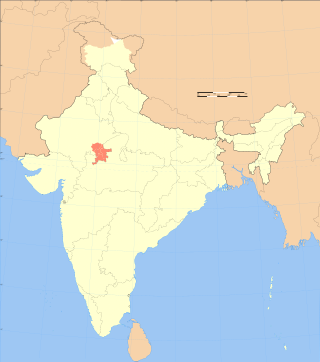
Hadoti is a region of Rajasthan state in western India, which was once called the Bundi Kingdom. The biggest cities are Jhalawar and Kota. It includes the districts of Bundi, Baran, Jhalawar and Kota and is bounded on the west by the Mewar, on the northwest by Ajmer regions of Rajasthan, and on the south by the Malwa, on the east by the Gird regions of Madhya Pradesh state.

The Kali Sindh (Krashna Sindhu), is a river in Madhya Pradesh and Rajasthan in northern India. It is a tributary of the Chambal River in the Ganges Basin. The main tributaries of the Kali Sindh are the Parwan, Niwaj and Ahu rivers. The Kali Sindh River drains a major portion of the Malwa region, and is the biggest river flowing in the Malwa region of Madhya Pradesh.

Jhalawar district is one of the 33 districts of Rajasthan state in western India. The historical city of Jhalawar is the administrative headquarters of the Jhalawar district. The district is bounded on the northwest by Kota district, on the northeast by Baran district, on the east by Guna district of Madhya Pradesh state, on the south by Rajgarh district and Agar Malwa district of Madhya Pradesh state and on the west by Ratlam district and Mandsaur district of Madhya Pradesh state. The district occupies an area of 6219 km². The district is part of Kota division. To know more about Jhalawar City
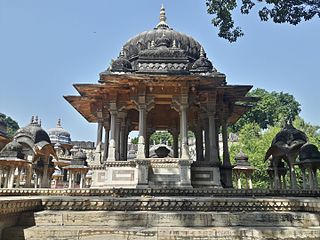
Kota District is a district of the state of Rajasthan in western India. The city of Kota is the administrative headquarters of the district.

Bundi is a district in the state of Rajasthan in western India. The city of Bundi is the district headquarters. It has an area of 5,550 km2 and a population of 1,110,906. It is divided into 5 tehsils which are: Bundi, Hindoli, Nainwa, Keshoraipatan and Indergarh.
Dhundhari (ढूंढाड़ी), also known as Jaipuri, is a Rajasthani language within the Indo-Aryan language family. It is spoken in the Dhundhar region of northeastern Rajasthan state, India. Dhundari-speaking people are found in four districts – Jaipur, Sawai Madhopur, Dausa, Tonk and some parts of Sikar, Karauli and Gangapur District.
Aklera is a town and an Indian municipality in Jhalawar district in the state of Rajasthan. It is in the south-eastern region of Rajasthan at the edge of the Malwa plateau and has a rocky, scrub-covered terrain.

Baran is a city in Baran district of the Indian state of Rajasthan. It is a municipality and the district headquarters of Baran district, famous for its 11th century Bhand Devra Temple on banks of Ramgarh crater. It is 339 km from the state capital Jaipur near Kota city. Three large rivers, Parban, Parbati, and Kalisindh, flow through the district.
Ahirwati is an Indo-Aryan dialect of India. It is spoken within the Ahirwal region located to the south-west of the capital Delhi. It belongs to the Rajasthani language group and is commonly taken to be a dialect of Mewati, but in many respects it is intermediate with the neighbouring varieties of Bangru and Bagri, and is especially close to Shekhawati.

The Punjabi dialects and languages or Greater Punjabi are a series of dialects and languages spoken around the Punjab region of Pakistan and India with varying degrees of official recognition. They have sometimes been referred to as the Greater Punjabi macrolanguage. Punjabi may also be considered as a pluricentric language with more than one standard variety.

The Central Indo-Aryan languages or Hindi languages are a group of Indo-Aryan languages spoken across Northern and Central India. These language varieties form the central part of the Indo-Aryan language family, itself a part of the Indo-European language family. They historically form a dialect continuum that descends from the Middle Prakrits. Located in the Hindi Belt, the Central Zone includes the Dehlavi (Delhi) dialect of the Hindustani language, the lingua franca of Northern India that is the basis of the Modern Standard Hindi and Modern Standard Urdu literary standards. In regards to the Indo-Aryan language family, the coherence of this language group depends on the classification being used; here only Eastern and Western Hindi languages will be considered.

The following outline is provided as an overview of and topical guide to Rajasthan:

